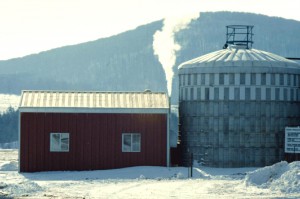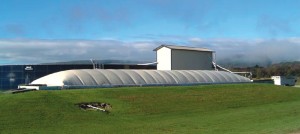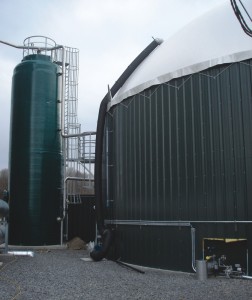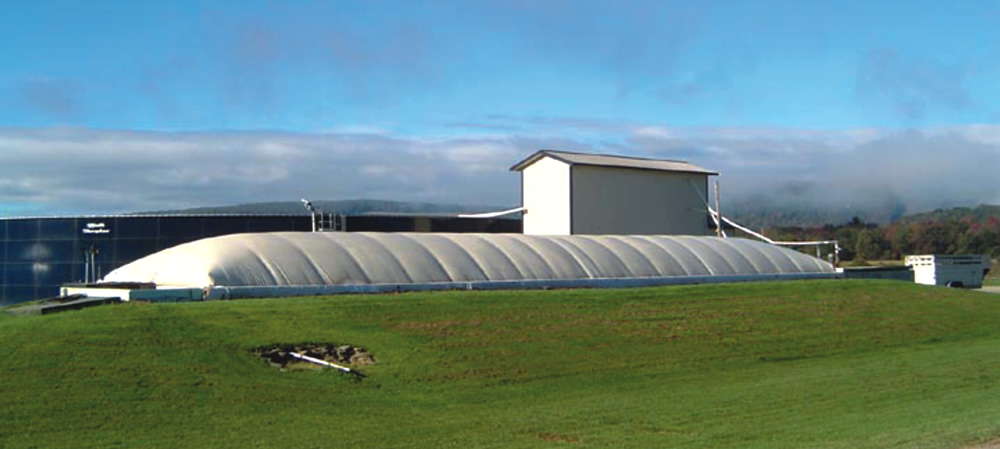Cornell University has been involved with anaerobic digestion systems on dairy farms for almost 40 years. A member of its PRO-DAIRY team discusses the past, present and future of AD in the Empire State.
Nora Goldstein
BioCycle February 2012, Vol. 53, No. 2, p. 41

Early digester research by Cornell contributed to the design and operation of the Agway Farm Research Center in Tully, NY (pictured here in 1981). Photo by Stan Weeks
And Cornell University, New York State’s land grant college in Ithaca, has been an integral part of the state’s farm digester evolution, beginning in the mid-1970s. Today, Cornell’s farm digester initiatives are within the Dairy Environmental Systems group under the Cornell PRO-DAIRY program. A multidisciplinary approach is used to address critical aspects of dairy farming and its impact on the environment. A major goal is to develop and deliver sound information and tools to dairy farmers and their advisors, engineered and packaged in ways that allow farmers to make informed business decisions in production areas that influence air and water quality, and the climate. Renewable energy (dairy manure-based anaerobic digestion) is a major focus area of the program.
According to the PRO-DAIRY Program 2011 annual report, there are 5,470 dairies with 611,000 cows in New York State. USEPA’s AgSTAR’s most recent data report 22 operating anaerobic digesters in New York State. All but one are processing dairy manure. On March 27-29, PRO-DAIRY is hosting, along with AgSTAR, the New York State Research and Development Authority (NYSERDA) and USDA’s Natural Resources Conservation Service, a national conference — “Got Manure? Enhancing Environmental and Economic Sustainability” — in Syracuse, New York. This issue of BioCycle will be distributed at the conference. We interviewed Curt Gooch, Dairy Environmental Systems and Sustainability Engineer with PRO-DAIRY, to gain insights into farm digester trends in New York.
BioCycle: It has been almost 40 years since Cornell University first became involved with anaerobic digestion on dairy farms in New York State. What created the initial interest?
Curt Gooch:Cornell University pioneered on-farm anaerobic digestion of dairy manure starting in the mid-1970s when alternative energy solutions were being pursued as a result of the 1973 oil embargo. Professor Emeritus William Jewell developed, tested and demonstrated plug-flow anaerobic digestion of dairy manure on local collaborating farms. Lower energy prices prevailed soon afterwards and that, along with relatively few farms of sufficient size to justify an anaerobic digester at that time, resulted in a loss of interest by the dairy industry. PRO-DAIRY became a major player in manure-based anaerobic digestion in the late 1990s, which was when the New York State dairy industry’s interest in anaerobic digestion was resurrected. The industry needed to reduce odor emissions from manure stored long-term and from application to cropland. Energy generation has also played a role in reducing farm costs of owning and operating their digesters. NYSERDA has played a critical role in this resurrection of anaerobic digestion in New York, first in the late 1990s and early to mid-2000s by providing substantial grant funds to farms to build digesters and most recently through implementation of the State’s renewable portfolio standard (RPS) program (see below).
BioCycle: How did PRO-DAIRY respond to the industry’s resurrection of interest?
Curt Gooch: In 2000, PRO-DAIRY was part of a team that received grant funds from NYSERDA, NYSEG (an electric and gas utility), and the New York City Watershed Ag Council to design, build, operate and assess an innovative digester design on the JJ Farber Farm, a 100-cow dairy farm located in the Catskill mountain area. At about the same time, a handful of other New York State dairy farms received grant funding to build plug-flow digesters. PRO-DAIRY assisted those farms during the feasibility and design phases. Then PRO-DAIRY received a grant from NYSERDA to monitor the performance of these digesters, which we did from 2002 to 2007. This work generated some of the first data in the U.S. about the long-term performance of farm digesters. In the mid-2000s, we also worked on a project to investigate the possibility of digesting raw and pretreated sand-laden dairy manure from cows bedded on sand.With all of this information in hand, NYSERDA provided us funding to develop and implement a technology transfer project from which we have delivered many extension/outreach documents, most of which are posted on our web site,
www.manuremanagement.cornell.edu. From 2008 to 2010, we performed another round of digester monitoring work, again with funding from NYSERDA. This time, we monitored seven digesters following the then recently released EPA/USDA/ASERTTI (Assoc. of State Energy Research & Technology Transfer Institutions) digester monitoring protocol. In addition to the requirements of that protocol, we also determined the effect that digesters had on greenhouse gas emissions.PRO-DAIRY has worked on several dairy manure digester feasibility studies, including our most recently completed feasibility study for the town of Lowville, New York in 2011. The study included an assessment of farm and nonfarm biomass resources available in and around the village of Lowville, an investigation into available options for codigesting them (various combinations of materials and site locations), an estimation of the biogas that could be produced by the various scenarios, the resulting energy produced and net energy available for use, and an economic profitability assessment for each of the options investigated. The recommendation is to further investigate one centrally located, complete mix digester that would codigest manure from 15 collaborating dairy farms and targeted nonfarm biomass substrates (initially whey, digested sludge and glycerin) generated nearby. PRO-DAIRY also provided technical and economic leadership for the Cayuga Renewable Energy project, whose goal is to connect several area digesters to an end user located in Auburn, New York with a biogas pipeline.

Around 2000, a handful of New York State dairy farms received grant funding to build plug-flow digesters, such as the one shown above. Photo by Curt Gooch
BioCycle: How does the New York State dairy industry view anaerobic digestion in terms of its cost and effectiveness as an option for managing manure, nutrients and odors?
Curt Gooch: Odor control is a requisite for many farms that store manure long-term as a water quality best management practice. Farmer testimony and neighbors alike have indicated that digesters significantly contribute to reduced farmstead odor emissions. Digested manure is more easily applied to cropland and it also can be applied in a timely fashion, even at times when untreated manure cannot. Better timing of application means more manure nutrients are used by the crop for growth purposes and thus there is less reliance on commercially produced fertilizers that have associated environmental implications and sustainability concerns. Digesters are not nutrient management tools, however, they are a great pretreatment device for post digestion treatment technologies used to condense nitrogen and phosphorus into separate streams. While nutrient separation practices are not widely used on dairy farms today, they do have application in some cases that can overall lower the cost of handling manure by the farm.In general, New York State farms currently consider digesters a low return on investment item compared to other investments the farm can make, such as adding more capacity to milk cows. But many farms view digesters as a necessary cost of doing business. Grant funds have helped reduce this from a pure “black and white” perspective to one that if a farm can get sufficient grant funding to cover a large portion of the capital cost of the digester, then they will try to construct one.
BioCycle: What have been some key findings by PRO-DAIRY researchers that have resulted in a shift in the way digesters are managed, and how by-products are utilized?
Curt Gooch: One of PRO-DAIRY’s missions is to conduct relative applied research and develop and deliver timely extension/outreach materials based on our work and others with the overall goal of assisting farmers in making informed business decisions. For example, one tool used for our performance monitoring evaluations is the capacity factor — basically the ratio of the amount of electrical energy produced by the system over a given period of time relative to the amount of electrical energy that could have been produced over that same period of time. For example, if data over a two week period indicates that an engine generator set produced 10,000 kWh of energy, and that same unit, if operated at full throttle continuously could have produced 20,000 kWh, then capacity factor is 0.5. In terms of biogas quantity and quality, our data is helpful in showing farms what the expected day-in day-out quantity and quality are for proposed systems. Many times, values for these items are used to compare with digester developer claims.Our laboratory analysis of several hundred digestate samples has provided a solid understanding of the effects anaerobic digestion has on manure nutrients. We know that while the total amount (mass) of nitrogen, phosphorus and potassium entering the digester exits the digester, there are some changes in the form of these nutrients from being plant unavailable to plant available.Finally, our analysis of greenhouse gas data collected has helped us show that on average, digesting two dairy cows’ worth of manure for a year and utilizing that gas for productive uses is equivalent to offsetting the GHGs associated with operating the average American car for one year.
BioCycle: What are some critical research needs for farm digesters going forward?
Curt Gooch: The digester bud is ready to blossom independent of any critical research needs. The main need for wider adoption is sustainable prices paid for anaerobic digester outputs. It costs more to produce electricity from an anaerobic digester system than it does from hydro or coal-fired electrical plants, but prices paid for renewable energy are not generally high enough to make digester projects a go without outside money to reduce the system capital cost. Overall, the high capital costs of anaerobic digesters and the relatively low return on investment is not a viable business model. Research opportunities exist to find and demonstrate ways to accelerate the digestion process thus reducing the digester vessel size per unit volume of influent thus providing the opportunity to reduce capital costs.Other areas of opportunity lie in identifying alternative uses for anaerobic digester outputs and by-products, as well as developing a better understanding of the range of possibilities of codigestion of manure with off-farm substrates. A number of farms in the U.S. are codigesting manure with whey and other food processing by-products but the extent that this is possible without overloading the sensitive microbiological digestion process needs in-depth examination. A better understanding will allow manure-based digesters to take on even more off-farm products for codigestion with confidence, thus providing a needed boost to the system’s economics.

The new Synergy digester in Wyoming County is the first biogas plant in the state to be designed specifically for codigestion of manure with food-grade organic waste and has a complete biogas clean-up system (on left). Photo by Curt Gooch
BioCycle: How does PRO-DAIRY view biogas markets with regard to gas pipeline injection, vehicle fuel and electricity? Where do you see the market heading?
Curt Gooch: Cleanup of raw biogas to pipeline quality gas destined for various applications such as home and industrial use — replacing natural gas — and as a transportation fuel replacing gasoline and diesel are all viable. There are no technological hurdles precluding this from happening. There are huge economies of scale for biogas cleanup to pipeline quality systems and the smaller commercially available ones are generally large enough to process gas from the largest digesters in place today. Wider span development of renewable natural gas and liquid renewable natural gas is based on identifying biogas supply sources that are of sufficient size to use gas cleanup and compression systems that are economically feasible to own and operate, resulting in end products that are less costly to generate.On the electricity front, it is difficult to generate electricity at the farm that is cost competitive with that generated by large coal-fired and hydro plants without other funds or policy in place to subsidize this. On the policy side, New York State has been a leader in the nation in providing opportunities for farms to generate electricity for their own use and then sell the excess to the grid through the Net Metering Law. This law has gone through several updates over the years with the most significant being increasing the size of on-farm engine generator sets from 125-kW to the current capacity of 1,000-kW. Another significant improvement of the Net Metering Law, just last year, was expansion of the number of farm meters (utility accounts) that a farm owner can net meter through. Originally it was one meter but last year the law was adjusted to allow 15 meters. Still, the reality is that higher values for renewable energy and/or broader policy are needed to provide opportunity for many farmers and others to own and operate manure-based anaerobic digesters.
BioCycle: Have you seen an increase in the number of farm digesters receiving source separated food waste, e.g., from grocery stores?
Curt Gooch: Receiving source separated food waste from waste generators such as grocery stores is not as widespread as one may intuitively think. While we have seen a few farms in recent years starting to do this, there are limitations to keeping it from happening more. Handling source separated waste at most existing farm digesters is not readily possible without renovations, as these materials tend to need to be handled as a solid product and most digesters are set up to handle liquid products. While equipment is available to retrofit digesters to also handle solid products, the challenges lies in securing a commitment to receive those materials to justify the cost to upgrade the existing manure-based digesters to handle them.Another consideration is justifying the increased labor required to operate digesters fed source separated wastes. These wastes are not free of “impurities” such as packaging materials and thus have caused increased operational costs to keep digester operational.
BioCycle: How would you sum up the general trend for anaerobic digestion of livestock manures, both in New York State as well as in the U.S.?
Curt Gooch: The current trends we are seeing for manure-based anaerobic digesters that we have seen in the recent past will continue — relatively slow growth, systems being implemented on larger farms that need requisite odor control, external grant funds or tax reduction strategies used to offset capital costs, etc. It does not look like digester projects are likely to get high tariffs in the foreseeable future, so the focus has to be on other attributes of digesters that can benefit the economics that haven’t been fully teased out in the U.S. One example is the way that effluent can be more easily handled after digestion, with the more timely application to cropland, i.e., when the plant nutrients are most needed and will be utilized. This replaces need for purchased fertilizers.If the U.S. places more value on renewable energy, the current trends could change. There is a large potential for growth of anaerobic digestion in the U.S., which is largely untapped at this time.













